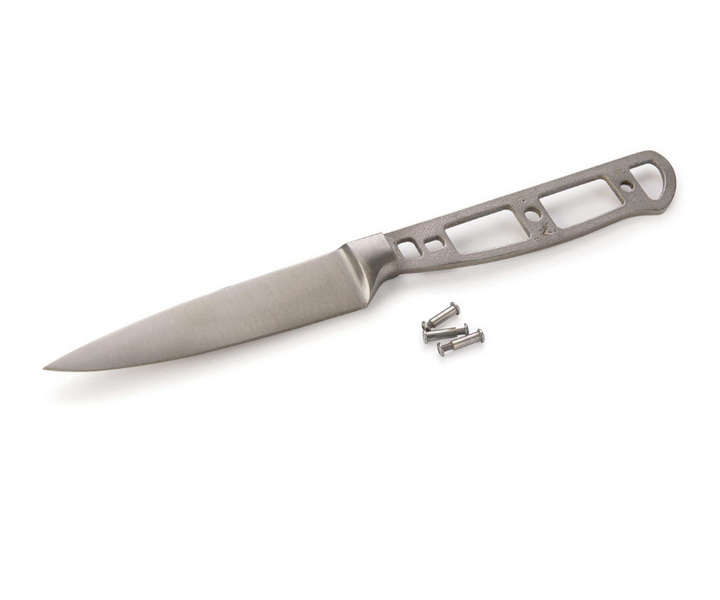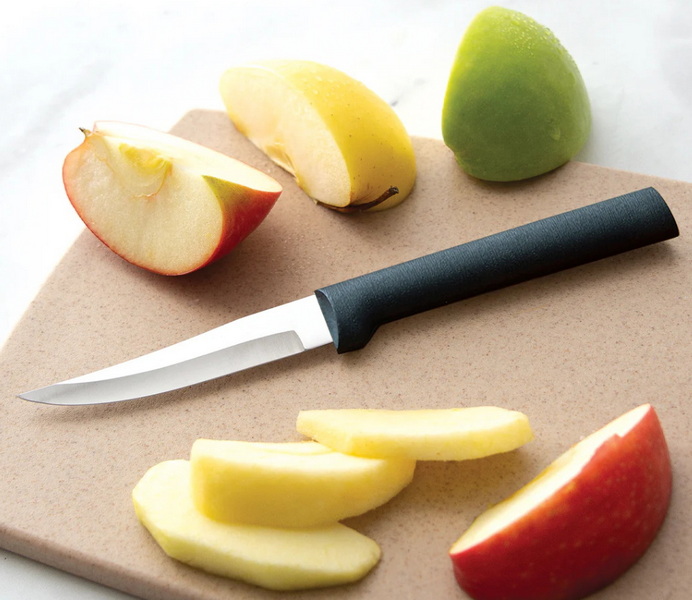- All
- Product Name
- Product Keyword
- Product Model
- Product Summary
- Product Description
- Multi Field Search
Views: 222 Author: Ann Publish Time: 2025-10-21 Origin: Site











Content Menu
● What Is a Paring Knife and Why Is It Ideal for Fruits?
● Key Features to Look For in Paring Knives for Fruits
● Top Paring Knives Recommended for Peeling Fruits
>> Classic Straight Blade Paring Knife
● How to Choose the Right Paring Knife for Your Fruit Tasks
● Importance of Balance and Weight
● Care and Maintenance Tips for Paring Knives
● Safety Tips When Using Paring Knives on Fruits
● Why Invest in a Quality Paring Knife?
● Frequently Asked Questions About Paring Knives for Fruits
>> 1. What makes a paring knife different from a utility knife?
>> 2. Can I use a paring knife to cut hard-skinned fruits?
>> 3. How often should I sharpen my paring knife for optimal performance?
>> 4. Is stainless steel better than high-carbon steel for paring knives?
>> 5. How should I store paring knives to keep them sharp and safe?
Paring knives are essential tools for any kitchen enthusiast, especially when it comes to intricate fruit preparations such as peeling, trimming, and slicing. This article explores the best paring knives on the market in 2025, detailing their features, materials, and ideal uses to help you select the perfect blade for fruit handling.

A paring knife is a small, versatile kitchen knife with a blade typically 2.5 to 4 inches long, designed for precision work. Its size and shape make it perfect for detailed tasks such as peeling away skins, trimming pulp, and slicing smaller pieces of fruit with control and accuracy. Unlike larger chef or utility knives, a paring knife offers maneuverability that lets you navigate the curves and tight spaces of fruits like apples, peaches, and kiwis without damaging the flesh.
Choosing the right paring knife for fruits depends on several important factors:
- Blade Material: Stainless steel is widely used for its rust resistance and ease of maintenance. High-carbon steel offers superior sharpness and edge retention but requires more care to avoid rust. Damascus steel combines beauty with durability, offering excellent cutting performance at a higher price point.
- Blade Shape and Edge: The straight blade is versatile and straightforward for general peeling and slicing. The curved or “bird's beak” shape is excellent for intricate peeling and shaping of round fruits. Serrated edges grip tougher skins like tomatoes or citrus fruits without crushing the delicate interior.
- Handle Comfort and Grip: Ergonomics matter since peeling and trimming often require hours of repetitive motion. Handles made from wood, plastic, or composite materials with non-slip grips reduce hand fatigue and improve safety.
- Blade Thickness and Sharpness: A thin blade is ideal for delicate slicing, while a slightly thicker blade might be needed for tougher skins or dense fruit flesh.
This is the most widely recognized style of paring knife. Its straight edge makes it a versatile tool for cleanly peeling apples, removing blemishes, or slicing small fruit segments. Many kitchen professionals prefer a narrow tip and balanced handle for precise control.
Characterized by its curved blade, the bird's beak or curved paring knife excels at peeling round fruits and detailed trimming. It easily follows the contours of a lemon or peach, allowing thin, continuous strips of peel to be removed without wasting edible fruit.
Ideal for fruits with tough skins and soft interiors such as tomatoes or kiwis, the serrated paring knife cuts through skin smoothly without crushing. This blade type maintains a sharper edge for longer when dealing with fibrous or waxy fruit peels.
Some paring knives feature an ultra-sharp point and extra fine blade that enable fruit carving or garnish creation. These are favored by chefs for artistic presentations, such as creating flower shapes from melon or intricate cuts on citrus zest.

When selecting a paring knife specifically for fruit work, keep in mind your personal cooking style and typical fruit varieties:
- If you primarily peel and slice apples, pears, and peaches, a classic straight blade knife with a comfortable grip will be ideal.
- For citrus fruits and intricately shaped garnishes, invest in a bird's beak or curved blade for easier peeling.
- For fruits with tough or waxy skins like tomatoes, avocados, and kiwi, a serrated paring knife will make clean cutting effortless.
- Consider blade length and handle size for hand comfort; a small-handed person will work better with a compact knife while larger hands require a larger handle to avoid fatigue.
| Material | Advantages | Disadvantages |
|---|---|---|
| Stainless Steel | Rust-resistant, easy maintenance | Dulls more quickly |
| High-Carbon Steel | Extremely sharp, easy to sharpen | Requires more care, susceptible to rust |
| Damascus Steel | Durable edge retention, visually appealing | Premium price |
A well-balanced paring knife feels like an extension of your hand, improving accuracy and reducing strain. Knives too light can lack cutting power, while overly heavy knives tire your wrist. Test knives by holding them to feel the center of gravity between the handle and blade.
Keeping your paring knife in prime condition ensures longer use and better performance:
- Always hand wash knives immediately after use to avoid corrosion and maintain sharpness.
- Use a honing rod regularly to keep the edge aligned and sharp.
- Store knives safely in a knife block, magnetic strip, or protective sheath rather than loose drawers.
- Avoid cutting on hard surfaces such as stone or glass; use wood or plastic cutting boards.
- Occasionally sharpen your paring knife professionally or with a whetstone for precision.
- Always cut away from your body and fingers to prevent injury.
- Use a stable cutting surface to avoid slips.
- Pay attention when peeling slippery fruits like grapes or tomatoes.
- Keep the knife sharp, as dull knives require more force and increase accident risk.
A good paring knife will last for years if cared for properly. Investing in professional-grade, ergonomically designed knives enhances your fruit preparation, reduces waste, and elevates the visual appeal of your dishes. For OEM manufacturers and international brands, offering a range of paring knives with varied blade shapes and premium materials will meet diverse consumer needs around the world.
Selecting the best paring knife for peeling, trimming, and slicing fruits enhances your kitchen efficiency and fruit presentation. Whether you prefer the classic straight blade, the curved bird's beak shape, or the serrated edge for tougher skins, investing in a high-quality paring knife tailored to your needs will transform everyday fruit preparation into a precise and enjoyable task. Pay attention to blade material, handle ergonomics, and blade shape to find the perfect tool that balances performance with comfort. Proper care and safety habits will ensure your knife remains sharp and durable for years to come.

Paring knives are smaller and designed for precise tasks like peeling and trimming fruits, while utility knives have longer blades suited to general cutting.
Yes, serrated paring knives are especially effective for cutting tough skins without damaging the interior.
If used frequently, sharpen it every few weeks and hone regularly to maintain the edge.
Stainless steel is easier to maintain and resist rust, but high-carbon steel holds a sharper edge longer with proper care.
Use knife blocks, magnetic strips, or blade guards to avoid dulling and potential injury from loose storage.
The Ultimate Professional Knives for Halal Butchery in Middle Eastern Kitchens
Chef Knife Size Guide: Choosing Between 6″, 8″, 10″, And 12″
Custom Knife Handles: How To Design A Chef Knife That Fits Your Hand Perfectly
Chef Knife Surface Treatments Guide: From Polished Migaki To Damascus Patterns
Inside Our Professional Knife Sample Room: Quality You Can See
Universal Knife Block Buying Guide: Modern Acrylic & ABS Knife Holders for Professional Kitchens
Universal Knife Block: The Complete Guide To Modern, Hygienic Knife Storage
The Complete Guide To Red Handle Knife Sets: Style Meets Functionality in The Kitchen
Professional Knives for Halal Butchery And Middle Eastern Cuisine